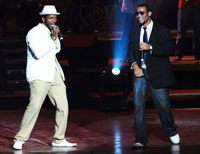13.26.1 Ogguere

In 1996, the idea of creating a Cuban rap group was conceived, which was born under the name “Cien por ciento original.” It was made up of Edrey Riverí (the group’s director) and Ulises Quiñones, who had been working together on small projects since 1988. Ulises was a member of the project “Amenaza,” which later became “Oricha.” They began working with Cuba’s first rap producer, the talented Pablo Herrera.
From the beginning, they decided that their creations would be marked by the fusion of rap with elements of other foreign rhythms such as jazz, funk, samba, and techno, and of course, with native rhythms such as cha-cha-chá, rumba, and mambo, among others. They achieved excellent results, gaining more and more followers at their performances in the country and, as a result, they were invited by the Aragón Orchestra to collaborate on the album “Aragón en Ruta,” which earned a Grammy nomination in the United States.
Ogguere, the name they chose to rebrand the group in 2001, means “soul of the earth” in Yoruba. They gradually began to take firm steps toward popularity with the song “Cómo está el Yogurt,” whose promotion was successfully supported by a video clip directed by the prominent Cuban artist Alexandre Arrechea.
That same year, the group won a Grammy for Best Tropical Latin Album for the song “Cha Cuba,” which was later included on their debut CD, “Llena de amor el mambo,” under the Asere de Producciones label of the Cuban Rap Agency. The album, recorded in 2002, featured collaborations with brilliant musicians such as Chucho Valdés and Pablo Milanés, and featured prominent artists such as Haydée Milanés, Diana Fuentes, Yulién Oviedo, Ruy Adrián López Nusa, Abel Calderón, Mayra Caridad Valdés, and Roberto Hernández, singer of Los Van Van (Robertón), among others. The album won an award in the hip-hop-rap-reggaeton category at the 2008 Cubadisco broadcast and gained a large number of new fans.
Along with renowned maestro Alina Orraca, Ogguere participated in an interesting piece by the choral group La Coralina, a piece that included some rap lines and for which her participation was requested.
Their voices have also contributed to the soundtracks of two film productions, one by Ernesto Daranas and the other by Esteban Insausti; and they were recently asked by Spanish actress Beatriz Luengo to record some backing vocals for inclusion on her upcoming album.
Ogguere knows how to incorporate endemic elements of Cuban music into hip hop, and with a very thoughtful approach, he achieves an authentic blend of rhythms where rap, rumba, and mambo, among other genres, are exquisitely fused.
Ogguere is currently working on their next album. This new production will pay tribute to Chano Pozo and will include ballads, boleros, and rumba, among other rhythms, in a multifaceted fusion of their original style of popular and conceptual music.








